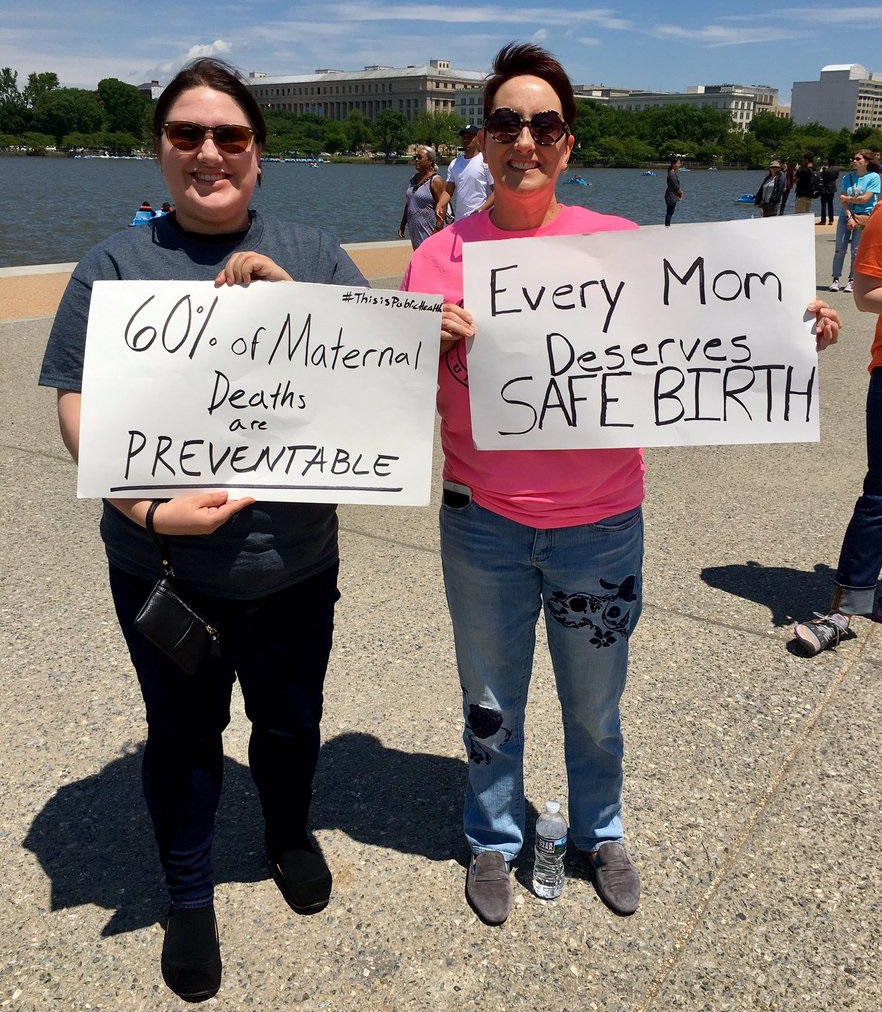Monthly Archives: June, 2017
WHERE IS THE M IN MCH? – MARCH FOR MOMS, WASHINGTON DC. MOTHER’S DAY 2017 Heading link

By Katie Garland, MPH
Alumna, UIC School of Public Health, Community Health Sciences and Maternal Child Health
Visiting Research Specialist, UIC Center for Research on Women and Gender
Thirty years ago, researchers asked “where is the M in MCH?”(Rosenfield & Maine 1985) Today, we are still asking ourselves the same question. Since 1980, infant mortality declined 52% in the US but during the same time, maternal mortality rose, defying global trends (Centers for Disease Control, MacDorman, Declercq, Cabral & Morton 2016). The US now has the worst maternal mortality ratio in the industrialized world (Kassebaum et al 2016, MacDorman et al. 2016). Maternal mortality does not affect all populations equally; Black mothers are three to four times more likely to die than White mothers (CDC Foundation 2017). Maternal mortality is a fixable problem; other countries have succeeded in dramatically lowering their rates. We know that at least half of maternal deaths in the US are preventable (CDC Foundation 2017). However, maternal health is woefully underfunded compared to infant and child health. Only 6% of MCH block grant funding is devoted to maternal health (Martin & Montagne, 2017). In a political climate where severe cuts to public health programs and the social safety net are likely, it is critical that maternal health advocates and stakeholders gather together and demand action. And gather we did.
On Mother’s day, over 100 maternal health stakeholders gathered at the Jefferson Memorial in Washington DC to march for America’s mothers. The best part of the march was the diversity of stakeholders that were involved. Representatives from ACOG, AABC, AWHONN, ACNM, and multiple nonprofits spoke at the march. Health practitioners, academics researchers, doulas, advocates, and families were all in attendance. The speakers discussed a wide range of maternal health topics including maternal mortality in the US and globally, postpartum depression, perinatal disparities in Black and Native communities, preterm birth, and stillbirth.
Some of the most powerful words came from Jennie Joseph, CPM and executive director of Commonsense Childbirth.
“I challenge you to reexamine how you think about what’s happening. This is not new. The system is broken and has been for decades. Let’s stop blaming the women. Let go of the judgement, the shaming, the discrimination, the stereotypes. Become aware of the conscious and unconscious biases that shape our OB care today. Recognize that these outrageous statistics cannot stand year in and year out without the acknowledgement or the impact of racism, classism, sexism. It’s killing our babies. It’s killing our mothers. “
The march was also an excellent opportunity to network with other maternal health stakeholders. I was able to discuss my current work in maternal health and make connections with researchers and advocates in many different areas of maternal health. The organizers hope to hold another march in DC next year.
Advocacy was another theme of the march. Attendees were encouraged to meet with their senators and representative before and after the march. Currently, there are bills in the House and Senate that would designate funding for maternal mortality review committees and grant funding for state projects addressing maternal mortality disparities. This is a critical step to ensuring accurate nationwide surveillance of maternal mortality. However, it is just the first step to addressing the broader issue of maternal mortality. In order to really prevent maternal deaths in the US, a variety of changes will need to happen. Equitable access to affordable, quality healthcare (including family planning), a robust social safety net, investments in the health of communities of color, and paid family leave will all help save the lives of the 700-900 American mothers who die every year.
References:
- Centers for Disease Control. Deaths: Final Data for 2013. Retrieved from: http://www.cdc.gov/nchs/data/nvsr/nvsr64/nvsr64_02.pdf
- CDC Foundation (2017). Report From Maternal Mortality Review Committees: A View Into Their Critical Role. Retrieved from: https://www.cdcfoundation.org/sites/default/files/upload/pdf/MMRIAReport.pdf
- Kassebaum, N. et al (2016). Global, regional, and national levels of maternal mortality, 1990–2015: a systematic analysis for the Global Burden of Disease Study 2015. The Lancet, 388(10053), 1775 – 1812. doi: http://dx.doi.org/10.1016/S0140-6736(16)31470-2
- Macdorman, M. F., Declercq, E., Cabral, H., & Morton, C. (2016). Recent Increases in the U.S. Maternal Mortality Rate. Obstetrics & Gynecology, 128(3), 447-455. doi:10.1097/aog.0000000000001556
- Martin, N., & Montagne, R. (Writers). (2017, May 12). Focus on Infants during Childbirth Leaves U.S. Moms in Danger [Transcript, Radio broadcast]. In Morning Edition. Washington DC: National Public Radio.
- Rosenfield, A., & Maine, D. (1985). Maternal Mortality-A Neglected Tragedy Where is the M in MCH? The Lancet, 326(8446), 83-85. doi:10.1016/s0140-6736(85)90188-6